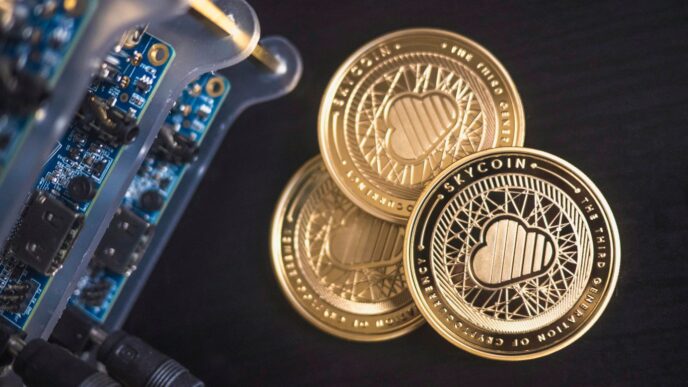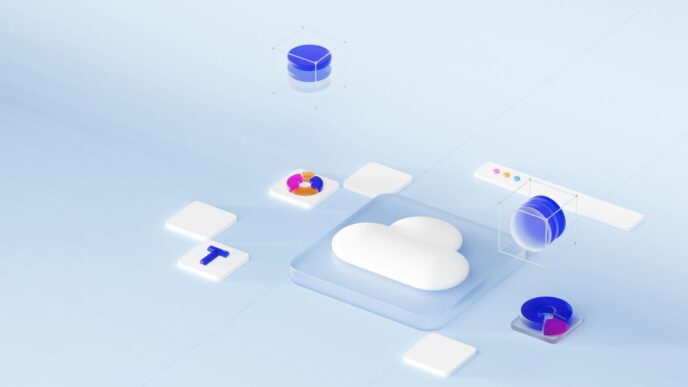Okay, so 2025 is shaping up to be a pretty wild year for tech. I’ve been sifting through all the buzz, and honestly, some of this stuff sounds like it’s straight out of a sci-fi movie. From AI that can actually do chores to cars that are practically spaceships, it’s a lot to take in. We’re talking about the best technology videos that really show off what’s coming next. It’s not just about gadgets anymore; it’s about how these new tools are changing how we live, work, and even how we think about the future. Get ready, because some of these innovations are seriously mind-blowing.
Key Takeaways
- Generative AI continues to be a major focus, with tools becoming more sophisticated and integrated into everyday tasks.
- Innovations in electric vehicles, like Honda’s 0 Series, are pushing the boundaries of design and performance.
- Consumer electronics are getting smarter and more specialized, from advanced TVs like LG’s OLED to unique devices like the Kirin Electric Salt Spoon.
- Wearable tech and health-focused gadgets, such as Nike x Hyperice and L’Oreal’s skin scanner, are becoming more prevalent.
- Robotics are making significant strides, with developments ranging from almost human-like robots to specialized machines that can perform specific tasks like making tortillas.
1. Generative AI
Okay, so Generative AI. It feels like this tech has been everywhere lately, right? It’s not just about making funny pictures or writing poems anymore, though it’s pretty good at that too. In 2025, we’re seeing generative AI get serious about helping businesses out.
Think about it: companies are using it to create all sorts of things, from marketing copy that actually sounds human to complex code that developers can build on. It’s like having a super-smart assistant that can churn out ideas and content at a speed we haven’t seen before. This isn’t just a novelty; it’s starting to change how products are designed and how customer service works.
Here’s a quick look at what’s happening:
- Content Creation: Generating text, images, music, and even video that’s hard to tell apart from human-made stuff.
- Software Development: Helping programmers write code faster and find bugs more easily.
- Product Design: Creating new designs for everything from car parts to consumer goods.
- Personalization: Tailoring experiences for customers in ways that feel really individual.
It’s still early days for some of these applications, and there are definitely things to figure out, like making sure the AI is fair and doesn’t make stuff up. But the pace of development is wild. The big story for 2025 is how generative AI is moving from a cool experiment to a practical tool that businesses are actually using to get things done. It’s going to be interesting to see where it goes next.
2. Quantum Computing
Okay, so quantum computing. It sounds like something straight out of science fiction, right? But it’s actually becoming a real thing, and 2025 looks like a big year for it. Basically, instead of using bits like regular computers (which are either a 0 or a 1), quantum computers use ‘qubits’. These qubits can be a 0, a 1, or both at the same time. This ‘superposition’ thing lets them do some seriously complex calculations way faster than anything we have now.
Think about it: problems that would take today’s best supercomputers ages to solve could potentially be figured out in minutes or hours with quantum computers. This has huge implications for a bunch of fields.
Here’s a quick look at what quantum computing could shake up:
- Drug Discovery and Medicine: Imagine designing new medicines or understanding diseases at a molecular level. Quantum computers could model complex biological systems with incredible accuracy, speeding up the development of new treatments.
- Materials Science: Creating new materials with specific properties, like super-strong, lightweight alloys or more efficient solar cells, could become much easier.
- Financial Modeling: Complex financial markets could be analyzed and predicted with greater precision, potentially leading to more stable economic systems.
- Artificial Intelligence: Quantum computing could supercharge AI algorithms, allowing them to learn and solve problems in ways we can’t even imagine yet.
Companies like PsiQuantum are working on building these machines using things like silicon photonics. It’s still early days, and there are big challenges to overcome, like keeping qubits stable and correcting errors. But the progress we’re seeing is pretty wild. It feels like we’re on the cusp of a new era of computation.
3. Bioprinting
Bioprinting is seriously one of those futuristic technologies that sounds like it’s straight out of a sci-fi movie, but it’s actually happening right now. Basically, it’s like 3D printing, but instead of plastic or metal, we’re printing with living cells. The goal is to create functional tissues and organs that could one day be used for transplants or to test new drugs.
Imagine being able to print a new kidney or liver for someone who needs one. That’s the dream, anyway. Right now, researchers are getting pretty good at printing simpler tissues, like skin or cartilage. It’s a complex process, and there are still a lot of hurdles to overcome before we’re printing whole organs.
Here’s a quick look at what’s involved:
- Cell Sourcing: Getting the right kind of cells is step one. These can come from a patient themselves or from cell banks.
- Bio-ink Formulation: Cells are mixed with a special gel-like material, called a bio-ink, that supports them and helps the printed structure hold its shape.
- Printing Process: A bioprinter then deposits the bio-ink layer by layer, following a digital blueprint of the tissue or organ.
- Maturation: The printed construct needs time in a special incubator to develop into functional tissue.
This technology has the potential to completely change how we approach medicine and drug development. Companies are working on new ways to make the printing process faster and more precise, which is key for creating complex structures. It’s a field that’s moving fast, and we’re seeing some really interesting advancements in tissue engineering that could make a big difference in patient care.
4. Honda 0 Series EVs
Honda is really shaking things up in the electric vehicle space with their new 0 Series. They’re not just talking about making EVs; they’re aiming to redefine what an electric car can be. The big idea here is to blend sleek design with practical, long-range performance, making EVs more appealing to everyone.
What’s interesting is how they’re approaching the design. Think minimalist, almost futuristic, but still grounded in what people actually want in a car. They’ve been showing off some concept vehicles that look like they just rolled off a sci-fi movie set, but the plan is to bring these ideas into production.
Here are a few things that stand out about the Honda 0 Series:
- Thin and Light Battery Design: They’re working on new battery tech that’s not as bulky as what we’re used to. This helps keep the cars lighter and allows for that sharp, low-profile look.
- Extended Range: Nobody likes range anxiety, right? Honda is pushing for these cars to go further on a single charge, so you can actually take those longer trips without constantly looking for a charging station.
- Fast Charging Capabilities: When you do need to charge, they want it to be quick. The goal is to get a significant amount of range back in a short amount of time, similar to how quickly you can fill up a gas tank.
- Focus on the Driving Experience: Beyond just the tech specs, Honda seems committed to making these cars fun to drive. That means responsive handling and a comfortable ride, whether you’re commuting or cruising.
It feels like Honda is trying to hit a sweet spot, offering something that looks good, performs well, and addresses some of the common concerns people have about switching to electric. It’s definitely one to watch if you’re curious about the future of electric cars.
5. LG G5 OLED TV
LG’s G5 OLED TV is making waves, and honestly, it’s pretty impressive. They’ve managed to pack some serious visual punch into a design that’s surprisingly thin. This TV really shows off what OLED technology can do when you push it.
What’s cool is how they’ve handled the picture quality. It’s not just about bright colors; it’s about the deep blacks and the way light and shadow play together. It makes watching movies or even just regular TV feel a bit more… real.
Here’s a quick look at some of the specs that stand out:
- Display Technology: OLED
- Resolution: 4K UHD
- Refresh Rate: 120Hz
- Smart TV Platform: webOS
It’s definitely a step up if you’re looking for a TV that makes your favorite shows look their absolute best. The sound is pretty decent too, with built-in speakers that do a good job without needing a soundbar right away. It’s a solid choice for anyone who cares about picture quality.
6. Kirin Electric Salt Spoon
So, you’re trying to cut back on salt, but your food just tastes… blah? It’s a common problem, right? Well, Japanese company Kirin has been tinkering with a solution that sounds like it’s straight out of science fiction: an electric salt spoon. This isn’t your grandma’s silverware; it uses a mild electrical current to trick your taste buds into thinking they’re tasting salt.
How does it work? You hold the spoon, and as you bring it to your mouth, tiny sensors on the handle activate. These sensors send a small jolt through the spoon, which then interacts with your saliva. The idea is that this electrical stimulation mimics the sensation of saltiness. It’s pretty wild when you think about it – using electricity to make food taste saltier without actually adding any sodium.
Now, it’s not perfect. The grip can feel a bit odd, and some people might find the sensation strange at first. It’s definitely an experimental piece of tech. But for anyone trying to manage their salt intake for health reasons, this could be a game-changer. Imagine enjoying your soup or your favorite dish with that satisfying savory flavor, all thanks to a little bit of science.
Here’s a quick rundown of what makes it interesting:
- The Goal: To provide a salty taste sensation without adding sodium.
- The Tech: A mild electrical current applied via a specially designed spoon.
- The Target Audience: Individuals on low-sodium diets for health reasons.
- The Status: Currently an experimental concept, not yet widely available.
7. Nike x Hyperice
Okay, so imagine your feet are just completely trashed after a long day, or maybe after a really intense workout. Nike teamed up with this company called Hyperice, which is all about recovery tech, to make something pretty wild. They’ve got these prototype "boots" – though they look more like sleek, high-tech sleeves – that you slip your feet into.
These things use a combination of targeted heat and air compression to really work on those sore muscles. You can actually adjust the intensity of both the heat and the compression right there on the device. I saw them demonstrated at CES, and honestly, the idea of getting that kind of targeted relief without having to manually massage your feet sounds pretty amazing. They were first used by athletes during the Paris Olympics, which tells you they’re aiming for serious recovery.
It’s basically a system of "dual-air Normatec bladders" all bonded with warming elements. While it sounds super technical, the main takeaway is that it’s designed to give your feet some serious TLC. It’s not quite a shoe you’d wear out and about, but for getting your feet back in shape after a tough day, this Nike x Hyperice tech looks like it could be a game-changer.
8. LG UltraGear 45GX990A
LG’s UltraGear line is usually a solid bet for gamers, and the 45GX990A is no exception. This monitor really stands out because it’s a bendable screen. Yeah, you heard that right. You can switch it from a flat display to a curved one with a simple adjustment. It’s a pretty neat trick that could make games feel more immersive, or just give you more screen real estate when you need it for work.
This monitor packs a punch with its high resolution, sitting at 5,120 x 2,160. That’s a lot of pixels, meaning your games and content will look super sharp. Plus, it supports different picture modes and refresh rate settings, so you can tweak it for whatever you’re doing. It’s a step up from many other gaming monitors out there, offering a flexible viewing experience that’s pretty unique.
Here’s a quick rundown of what makes it interesting:
- Bendable Screen: Go from flat to curved on demand.
- High Resolution: 5,120 x 2,160 for crisp visuals.
- Dual Mode Support: Adapt refresh rates and picture sizes.
- Large 45-inch Panel: Plenty of screen for gaming and multitasking.
9. Flint Paper Battery
Okay, so batteries. We all need them, but they’re kind of a pain, right? They’re not exactly eco-friendly, and sometimes they just don’t last long enough. Enter Flint, a startup from Singapore that’s trying to shake things up with a battery made from paper. Seriously, paper.
They’re using cellulose, which is basically the stuff that makes up plants and trees. This material is pretty good at letting the electrical stuff move between the positive and negative parts of the battery. The cool thing is, this paper battery is flexible and can be made really small. Imagine a battery thin enough to be built right into your watch strap. Plus, since it’s made from natural stuff, it’s biodegradable. This could be a big deal for making our gadgets more sustainable and less wasteful. It’s still early days, but it’s definitely one of those innovations that makes you think about what’s next for portable power.
10. JSAUX FlipGo Horizon
You know how sometimes you just wish your laptop had more screens? Like, for real. JSAUX seems to get it. They’ve been showing off their FlipGo Horizon, which is basically a set of snap-on displays for your laptop. It’s one of those ideas that pops up at CES every year, and honestly, most of them are just… meh. But this one actually caught my eye. It’s designed to give you that multi-screen setup without a ton of hassle.
Think about it:
- More space for multitasking: Imagine having your main work on one screen, your research on another, and maybe your social media or music on a third. It could really change how you get things done on the go.
- Portability: The whole point is to add screens without making your setup a giant pain to carry around. JSAUX is aiming for something that attaches easily and doesn’t add too much bulk.
- Potential for productivity: For people who work from coffee shops or travel a lot, having extra screen real estate can be a game-changer. It means less switching between windows and more focus on the task at hand.
It’s still early days, and we’ve seen these kinds of add-ons before that didn’t quite hit the mark. But the FlipGo Horizon looks promising. It’s the kind of tech that could make a real difference for digital nomads or anyone who just likes having more digital real estate.
11. LeafyPod
Okay, so let’s talk about LeafyPod. If you’re like me, you’ve probably tried to keep a plant alive and failed miserably. It’s not always easy to know what they need, right? Well, LeafyPod is trying to fix that. It’s basically a smart planter that figures out what your specific plant needs to thrive. It monitors things like water, light, and other environmental stuff. The coolest part is that it actually tells you what the plant needs through a phone app. So, instead of guessing, you get a notification saying, ‘Hey, I’m thirsty!’ or ‘Could use a bit more sun over here.’ You still have to do the actual watering and moving, of course, but it takes a lot of the guesswork out of plant care. It’s like having a little plant whisperer right in your home.
12. Roam SodaTop
Remember those SodaStream machines? They were pretty neat for making fizzy drinks at home. Well, Roam is taking that idea on the go with their SodaTop.
This thing is basically a cap that you can screw onto compatible water bottles. It lets you add carbonation to your water pretty much anywhere. No more being stuck with flat water when you’re out and about. It’s a simple concept, but honestly, it makes a lot of sense in our mobile world. You just need a compatible bottle and a source of CO2, and you’re good to go. It’s one of those gadgets that makes you think, “Why didn’t I think of that?” It’s all about bringing a little bit of convenience and customization to your everyday hydration, wherever you happen to be.
13. Samsung’s Micro LED Smartwatch Concept
Okay, so Samsung showed off a smartwatch concept that uses Micro LED tech. You know, the kind of display that’s super bright. This means you could actually see your watch face, even when the sun is beating down. It’s still just a concept, so don’t expect to buy one tomorrow. But it’s pretty cool to think about what might be possible down the road.
Imagine a smartwatch that doesn’t struggle in bright sunlight. That’s the idea here. Micro LED displays are known for their brightness and color accuracy, which would be a big win for a device you wear on your wrist and use outdoors a lot.
Here’s what makes it interesting:
- Visibility: The main selling point is how bright the screen can get. No more squinting to check the time or notifications.
- Potential: While it’s a concept, it shows Samsung is thinking about pushing smartwatch display technology forward.
- Future Tech: Micro LED is still pretty new and expensive, which is why it’s a concept for now. But we’ve seen it in TVs, and now it might be coming to our wrists.
14. Farmonaut
Farmonaut is really shaking things up in the agriculture tech world, especially with how they’re using satellite data. It’s not just for the big guys anymore; they’re trying to make this powerful information available to pretty much anyone involved in farming, from individual growers to government folks.
What they offer is a mix of things. You get satellite images that show you what’s happening with your crops and soil in real-time. Then there’s this AI system, called Jeevn, that gives you advice tailored to your specific crops or the weather. They’re also using blockchain for tracking things from the farm all the way to your plate, which sounds pretty neat for transparency. Plus, they have tools to keep an eye on resources and even monitor your carbon footprint.
It’s pretty cool how they’ve broken down who can use their stuff:
- Individual Farmers: Get detailed satellite views of their crops without breaking the bank.
- Businesses and Governments: Manage large farming operations or rural projects with cloud-based analysis.
- Financial Institutions: Use the platform to check out farmland remotely, which helps with loans and insurance.
They even have an API for developers who want to plug this satellite data into their own systems. It’s all about making farming smarter and more sustainable, and Farmonaut seems to be a big part of that push.
15. L’Oreal’s New Cell-Reading Device
Okay, so L’Oreal has been doing some pretty wild stuff in the beauty tech space, and their latest gadget is no exception. They’ve come up with this new device that can apparently read your skin cells. Think of it like a super-fast skin check-up, but way more advanced.
It’s designed to figure out exactly what your skin needs right now, in just a few minutes. No more guessing if you need more hydration or a different serum. This thing gets down to the cellular level to give you a personalized diagnosis. It’s pretty wild to imagine technology getting that specific with something as personal as our skin.
Here’s a rough idea of how it might work:
- Scanning: The device uses some kind of advanced imaging or sensor technology to look at your skin cells.
- Analysis: It then processes the data it collects, looking for specific markers or conditions.
- Recommendation: Based on the analysis, it tells you what your skin is lacking or what it needs to improve.
It’s still early days for this kind of tech, but the idea of getting such precise information about your skin’s health is pretty compelling. It could really change how we approach skincare routines, making them way more effective and less of a shot in the dark. I’m curious to see how this develops and if it becomes something we can all use at home someday.
16. AI Learned to Do Laundry

Okay, so laundry. It’s one of those chores that just never seems to end, right? Well, it looks like artificial intelligence is finally getting its act together to tackle this never-ending cycle. We’re seeing some pretty neat developments where AI is being trained to actually sort, fold, and maybe even put away our clothes.
Think about it: no more sorting whites from colors, no more wrestling with fitted sheets. This isn’t just about convenience; it’s about freeing up time for things we actually want to do.
Here’s a peek at what this might look like:
- Sorting: AI vision systems can identify different fabric types, colors, and even stains, deciding what goes where.
- Folding: Robotic arms, guided by AI, are learning to handle different garments, from t-shirts to towels, with surprising dexterity.
- Washing/Drying Optimization: AI could also learn to optimize wash cycles based on load type and soil level, potentially saving water and energy.
It’s still early days, and you won’t have a robot butler doing your laundry tomorrow. But the progress is real, and it’s exciting to imagine a future where this mundane task is handled for us. It’s about time, honestly.
17. Window Heat Pump
Okay, so imagine this: you’re renting a place, and it gets chilly. Normally, you’re stuck with space heaters or maybe a clunky portable unit. But what if you could just pop in a heater like you would an air conditioner? That’s the idea behind these new window heat pumps. They’re designed to be super easy to install, no permanent changes needed, which is a big deal for anyone who can’t mess with their landlord’s property.
These units are pretty neat because they offer a way to heat your space without a huge hassle. Think of it like a window AC, but for warmth. It’s a clever bit of tech that could make a lot of rental apartments or rooms much more comfortable during the colder months. Plus, they’re aiming to be more energy efficient than older heating methods, which is always a plus for your wallet and the planet.
Here’s a quick rundown of what makes them stand out:
- Easy Installation: Just like a window AC unit, these are meant to slot right into your window frame.
- No Permanent Fixtures: Great for renters who can’t make structural changes.
- Energy Efficiency: Generally more efficient than traditional electric heaters.
- Supplemental Heating: Perfect for adding warmth to a specific room or a smaller living space.
It’s exciting to see innovations like this that address common problems for people living in rented spaces. It’s not quite a whole-house solution, but for targeted heating, it’s a really practical idea. You can find out more about these kinds of rental-friendly heating solutions that are popping up.
18. Robot That’s Almost Human
Okay, so you know how sometimes you see those robots in movies that look and act exactly like people? Well, it turns out we’re getting pretty darn close to that in real life. At CES 2025, there was a robot that really made you do a double-take. It could blink, move its eyes, and even show facial expressions that felt surprisingly natural.
It wasn’t just about looking human, though. This bot was designed to interact in ways that felt more intuitive. Think about how you might ask a friend for help or just have a casual chat – this robot was starting to get there. It’s a big step from the clunky machines we’re used to.
Here’s what stood out:
- Realistic Facial Movements: The ability to blink and shift its gaze made it seem much more alive.
- Expressive Capabilities: Showing subtle emotions, even if programmed, adds a new layer to human-robot interaction.
- Potential for Companionship: While still early days, this level of human-like interaction opens doors for robots in caregiving or even just as helpful assistants around the house.
It’s wild to think about the possibilities. Imagine robots that can genuinely understand and respond to your emotions, not just follow commands. This kind of tech could really change how we live and work. We’re still a ways off from a full-on sci-fi scenario, but seeing this robot was a pretty clear sign that the future is arriving faster than we think. It makes you wonder what other advancements in automation we’ll see next year.
19. Penguin’s Tummy
Okay, so this one is a bit out there, but honestly, it’s kind of charming. The ‘Penguin’s Tummy’ isn’t a real penguin, obviously. It’s more of a relaxation device. Think of it like a weighted plush toy, but with a gentle, rhythmic pulsing action designed to mimic breathing. The idea is to help you de-stress by focusing on its slow, calming movements.
It’s pretty simple, really. You just hold it, or place it on your chest, and let the subtle vibrations guide your breathing. It’s not trying to be a high-tech gadget; it’s more about that tactile, sensory experience.
Here’s what it aims to do:
- Provide a physical anchor for mindfulness exercises.
- Offer a comforting sensation for anxiety or stress.
- Encourage slower, more deliberate breathing patterns.
It’s definitely a niche product, but for anyone looking for a low-tech way to find a moment of calm, it’s an interesting concept. It’s like a hug you can hold onto when things get a bit much.
20. Robot Made a Tortilla

You know, it’s funny how we take things for granted. Like tortillas. They just appear in the grocery store, right? Well, at CES 2025, I saw a robot that actually made a tortilla. And not just any tortilla, but a pretty decent-looking one, all hot and fresh, in less than a minute. This little machine churned out a perfectly cooked tortilla right before my eyes. It was kind of mesmerizing, honestly.
It makes you wonder about the future of food prep. We’ve seen robots doing burgers and other complex tasks, but a simple tortilla feels like a big step for everyday cooking automation. It wasn’t just about speed, either. The robot seemed to handle the dough with a surprising amount of care, pressing and cooking it evenly.
Here’s a quick rundown of what I observed:
- Speed: The whole process, from dough to finished tortilla, took under 60 seconds.
- Quality: The tortilla looked evenly cooked, with a nice texture.
- Automation: It’s a clear sign that more food-making tasks are heading towards robotic assistance.
While it might not replace your favorite taqueria just yet, seeing a robot whip up a staple like a tortilla really makes you think about how technology is changing even the most basic parts of our lives. It’s a small thing, but it’s a big deal for the future of automated kitchens. Maybe soon, robots will be making all our favorite flatbreads, like the ones you can find at a burrito chain.
21. Smart Ring
Okay, so smart rings. They’ve been around for a bit, but 2025 seems to be the year they’re really stepping up. Forget bulky watches; these little bands are packing some serious tech right on your finger. The big news this year is how many of them are focusing on health monitoring, and not just step counting.
Some of these new rings are designed to keep an eye on your heart. We’re talking about detecting things like atrial fibrillation, which is that irregular heartbeat that can sometimes lead to bigger problems like strokes. It’s pretty wild to think a small ring can do that, right? It’s like having a tiny health guardian with you all the time.
Here’s a quick look at what makes some of these rings stand out:
- Heart Health Monitoring: Advanced sensors can spot irregular heart rhythms, giving you a heads-up before a serious issue occurs.
- Sleep Tracking: Beyond just how long you slept, they analyze sleep stages and quality.
- Activity and Recovery: They track your workouts and also give insights into how well your body is recovering.
- Stress Levels: Some models can even gauge your stress throughout the day.
It’s not just about the data, though. The design is getting a lot of attention too. You can find them in all sorts of finishes, from sleek, modern looks to more classic, almost jewelry-like styles. Some companies are even offering luxury options, like gold bullion designs, if you’re looking to make a statement. The idea is to blend advanced technology with everyday style, making health tracking less of a chore and more of a natural part of your life. It’s a pretty neat development, and I’m curious to see how many people actually ditch their smartwatches for these finger-friendly gadgets.
22. May Mobility Self-Driving Minibus
You might have seen these around, but May Mobility’s self-driving minibuses are really starting to make a splash. They’re not just some far-off concept anymore; these vehicles are actually out there, picking up passengers and getting them where they need to go. It’s pretty wild to think about, right?
These aren’t your typical ride-sharing cars. They’re designed to be accessible and comfortable, sort of like a small shuttle bus but with a whole lot more tech packed in. The goal is to make getting around easier, especially for people who might have trouble with traditional transportation. Think about it: no more worrying about parking or navigating busy streets. May Mobility is focused on bringing autonomous rides to everyday life.
Here’s a quick look at what makes them stand out:
- Accessibility Features: They’ve put thought into making sure people with different needs can use them, which is a big deal.
- Safety First: Like any self-driving tech, safety is the top priority. They’ve got a lot of sensors and systems working together.
- Community Focused: The idea is to serve specific areas, making local travel smoother and more convenient for residents.
It’s still early days for widespread adoption, but seeing these vehicles in action gives you a glimpse into the future of getting around. They’ve even partnered up with companies like Lyft to test out these services in places like Atlanta, showing a real push towards making autonomous rides a reality for more people. It’s a step towards a different kind of urban transit.
23. Hyve Outdoor Locker
Okay, so you know how packages sometimes just… disappear from your porch? It’s a real bummer, and honestly, a bit of a headache. Well, the Hyve Outdoor Locker is trying to fix that. It’s basically a secure spot for your deliveries right outside your door. Think of it like a mini vault for your online shopping hauls.
Installation might be a bit of a process, needing building approval and all, and it’s not exactly cheap. But the idea is pretty solid. You get a notification when something’s dropped off, and you can grab it whenever you’re home. It’s a neat bit of tech aimed at stopping porch pirates and making life a little easier when you’re expecting a delivery. It’s one of those things that makes you wonder why it wasn’t invented sooner, right? For anyone who orders a lot online, this could be a game-changer for package security.
24. Shokz OpenMeet Bone-Conducting Gamer Headset
Alright, let’s talk about the Shokz OpenMeet. If you’re a gamer, you know how important good audio is, but sometimes those bulky headphones can be a real pain, especially during long sessions. Shokz is trying something different here with their bone-conducting technology. Instead of covering your ears, these headsets send sound vibrations through your cheekbones directly to your inner ear. This means you can hear your game perfectly while still being aware of what’s going on around you. Pretty neat, right?
It’s not just about the tech, though. The OpenMeet is designed for comfort, which is a big deal when you’re trying to focus on a match. They’re lightweight and supposed to stay put, even when things get intense. Plus, being able to hear your teammates and your surroundings could be a game-changer for certain types of games or even just for safety.
Here’s what makes it stand out:
- Situational Awareness: Hear game audio and your teammates clearly without blocking out ambient sounds like doorbells or someone calling your name.
- Comfort: Designed for extended wear, aiming to reduce the ear fatigue some people get from traditional headsets.
- Connectivity: Offers flexible connection options, making it easier to switch between your PC, console, or even your phone.
While it’s not going to replace a high-end surround sound system for pure audio immersion, the Shokz OpenMeet offers a unique approach to gaming audio that prioritizes awareness and comfort. It’s definitely worth checking out if you’re tired of the usual headphone experience.
25. Fuzzy Sloth Baby Robot and more
Okay, so we’ve seen some pretty wild stuff this year, right? But sometimes, it’s the little things that really stick with you. Like this fuzzy sloth baby robot. Seriously, it’s probably the cutest thing I’ve laid eyes on. It’s not just about looks, though. These kinds of robots are showing us how far we’ve come in making machines that feel more approachable, even cuddly.
Beyond the adorable, there were a bunch of other neat gadgets and concepts that didn’t quite fit into the bigger categories but were still super interesting. Think about things like:
- A robot that can make a tortilla. Yep, you heard that right. Watching it work was surprisingly mesmerizing, and honestly, it makes you wonder what other everyday tasks robots will be handling soon.
- A smart ring that might replace your wedding band. It’s a bold idea, but these rings are packing a lot of tech into a tiny package. We’re talking health tracking and more, all disguised as jewelry.
- A penguin’s tummy that helps you relax. Okay, this one’s a bit out there, but it’s designed to help with breathing exercises. It inflates and deflates, mimicking a gentle breath. Weird? Maybe. Effective? Who knows!
It’s these kinds of innovations, from the incredibly cute to the surprisingly practical (and sometimes just plain odd), that really show the breadth of what’s happening in tech. It’s not all about massive AI models or quantum leaps; sometimes, it’s about making life a little more fun, a little easier, or just a little bit cuter.
Wrapping Up the Future
So, that’s a look at some of the cool tech stuff that’s making waves in 2025. From making fizzy drinks anywhere to smart planters that tell you when your plant is thirsty, it feels like technology is really trying to make everyday life a bit easier, or at least more interesting. We saw some neat ideas for health, home, and even how we grow our food. It’s pretty wild to think about what’s next, but one thing’s for sure: the pace of change isn’t slowing down. Keep an eye out, because the next big thing is probably just around the corner.
Frequently Asked Questions
What kind of new technologies can we expect to see in 2025?
Get ready for amazing tech in 2025! We’re talking about super-smart AI that can create things, mind-bending quantum computers, and even ways to print body parts using bioprinting. Plus, there will be cool new electric cars from Honda, amazing TVs from LG, and gadgets that make everyday life easier, like special spoons that can make food taste saltier and smart planters for your plants.
Are there any new electric vehicles coming out?
Yes! Honda is launching its new ‘0 Series’ electric vehicles, which are designed to be sleek and efficient. Imagine driving the future with these innovative cars hitting the road.
What’s new in home entertainment technology?
LG is showing off its impressive G5 OLED TV, promising stunning picture quality. For gamers, LG also has the UltraGear 45GX990A monitor, which is curved and can even bend from curved to flat, offering a super immersive experience.
How is technology helping us with health and wellness?
There are some really neat health tech inventions. L’Oreal has a new device that can read your skin to figure out exactly what it needs. Plus, Nike has teamed up with Hyperice to create special boots that use warmth and air pressure to help tired feet recover after a long day.
What are some of the most surprising or unique tech gadgets for 2025?
This year has some really unique items! There’s an electric salt spoon that can make food taste saltier without adding actual salt, which is great for people watching their salt intake. Also, check out the LeafyPod, a smart planter that tells you exactly what your plant needs. And for fun, there’s a fuzzy sloth baby robot that’s incredibly cute!
Will AI continue to be a big part of new technology?
Absolutely! AI is everywhere in 2025. We’re seeing generative AI that can create content, AI learning to do chores like laundry, and even robots that are getting closer to seeming almost human. AI is definitely shaping how we live and work.














